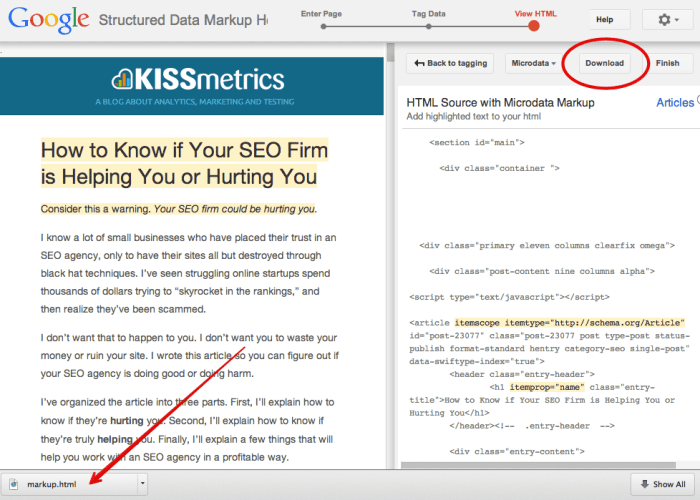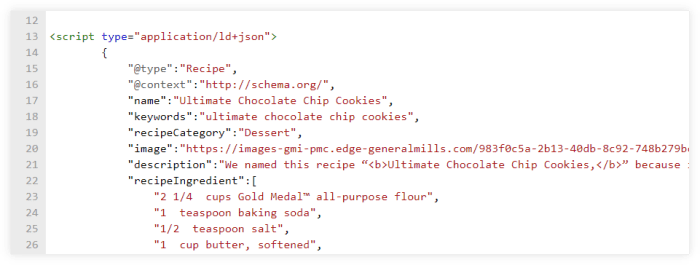Schema Markup Enhancing SEO with Structured Data
Schema Markup: Enhancing SEO with Structured Data – Schema Markup: Enhancing with Structured Data provides a comprehensive guide to optimizing website content for search engines. It explores the intricacies of structured data, demonstrating how it empowers search engines to better understand and interpret web pages. This process leads to improved search rankings, thereby driving organic traffic and ultimately boosting a website’s visibility.
This detailed guide covers everything from basic implementation techniques to advanced strategies for specific content types like products, articles, and events. It delves into the different methods for implementing Schema Markup (microdata, RDFa, JSON-LD), emphasizing the advantages and disadvantages of each approach. Furthermore, it includes practical examples and tables for easy understanding and implementation.
Introduction to Schema Markup
Schema markup is a standardized vocabulary of tags used to describe the content of a webpage. These tags help search engines understand the meaning and context of the information presented, enabling more accurate indexing and improved search results. It’s essentially a structured way to tell search engines what your content is about, allowing them to display richer snippets in search results.Employing schema markup significantly enhances a website’s visibility in search engine results pages (SERPs).
By providing more detailed information about the content, search engines can display richer snippets, often including images, ratings, and other details. This improved visibility can attract more clicks, leading to increased traffic and ultimately, a higher return on investment for the website.
Schema Markup Vocabularies
Various schema vocabularies exist, each designed for specific types of content. These vocabularies are standardized by schema.org, a collaborative effort among search engines. Understanding these different vocabularies is crucial for effectively applying schema markup. Different vocabularies cater to distinct content types, such as products, events, and reviews.
Applications of Schema Markup
Schema markup’s versatility extends across numerous website types. Businesses can use schema markup to describe products, services, and events, enabling search engines to present richer results. News publishers can use schema markup to highlight key details, like author and publication date, within search results. Schema markup isn’t limited to specific industries; its applications are wide-ranging.
Role of Structured Data in Search Engine Understanding
Structured data plays a vital role in how search engines interpret and display information. By providing structured data, websites essentially offer a blueprint of their content, allowing search engines to better understand its meaning and context. This structured format enables search engines to understand the relationships between different elements on a page, leading to more accurate indexing and improved search results.
Search engines can accurately display relevant information to users by understanding these relationships, such as the author, publication date, and other essential elements of a news article.
Common Schema Markup Types and Search Engine Benefits
This table Artikels common Schema Markup types and their corresponding benefits for search engines.
| Schema Markup Type | Search Engine Benefits |
|---|---|
| Product | Displays product details like price, availability, and reviews in search results. |
| Article | Highlights author, publication date, and other important article details in search results, enabling better organization and clarity. |
| Event | Shows event dates, times, locations, and other relevant details in search results. |
| Person | Displays author information and expertise in search results, helping to establish credibility. |
| Review | Displays star ratings and reviews in search results, making it easier for users to gauge quality. |
Implementing Schema Markup

Source: neilpatel.com
Schema markup is a crucial tool for enhancing search engine optimization (). By providing structured data about your website’s content, you enable search engines to better understand and interpret it. This, in turn, can lead to higher rankings in search results and improved click-through rates. Effective implementation of schema markup requires understanding different methods and applying them correctly.Implementing schema markup involves using standardized vocabulary to describe your content.
This allows search engines to comprehend the context of your pages and display rich snippets in search results. Using schema markup can greatly improve the visibility and engagement of your web pages.
Schema Markup Implementation Methods
Different methods exist for implementing schema markup. Understanding the distinctions between these methods is essential for choosing the most suitable approach for your website. The three primary methods are microdata, RDFa, and JSON-LD.
- Microdata: This method involves embedding schema markup directly within the HTML of your web pages using special attributes. It’s a straightforward approach for basic implementations, particularly for smaller websites or those already using HTML-centric design. Microdata uses special attributes like
itemscopeanditemtypeto tag the data elements, directly within the HTML tags. This allows search engines to quickly identify and interpret the data. - RDFa: RDFa (Resource Description Framework in Attributes) is another method for embedding schema markup in HTML. It utilizes attributes to add semantic meaning to HTML elements. It’s more flexible than microdata and allows for more complex relationships between data elements. RDFa utilizes attributes like
about,typeof, andpropertyto provide semantic context. - JSON-LD: This method uses JavaScript Object Notation for Linking Data, and it embeds schema markup within a separate JSON-LD block within the HTML page. This method is particularly useful for more complex implementations or for websites that already heavily utilize JavaScript. It provides better structure and readability for larger datasets. JSON-LD’s format makes it easier to maintain and update complex schema markup implementations.
Implementing Schema Markup Step-by-Step
A structured approach to implementation is crucial for accuracy and effectiveness.
- Identify the Schema Type: Determine the type of content you want to mark up (e.g., product, article, event). This dictates the specific schema you’ll need to use. For example, if you’re showcasing a product, you might use the schema.org ‘Product’ vocabulary.
- Choose an Implementation Method: Select the most appropriate method (microdata, RDFa, or JSON-LD) based on your website’s structure and complexity. Consider the level of technical expertise on your team and the scalability of your future needs when making your decision.
- Structure the Data: Arrange the data elements of your content according to the schema’s requirements. Pay close attention to the specific properties and attributes the schema expects. Ensure data consistency and accuracy for optimal results.
- Insert the Markup: Integrate the schema markup into your website’s HTML. Follow the guidelines for the chosen method (microdata, RDFa, or JSON-LD) to correctly embed the structured data.
- Validate the Markup: Use online validators to ensure the markup is correct and conforms to schema.org standards. This helps to avoid errors and ensures that search engines can correctly interpret the data.
- Test and Monitor: After implementation, test the markup to verify it displays correctly in search results. Regularly monitor the impact of the schema markup on your website’s search performance and make necessary adjustments as needed.
Advantages and Disadvantages of Implementation Methods
A comparative analysis of each method can help determine the best approach for a specific use case.
| Method | Advantages | Disadvantages |
|---|---|---|
| Microdata | Simple to implement, easy to understand, good for small-scale projects | Less flexible than RDFa or JSON-LD, can become cumbersome for complex data structures |
| RDFa | More flexible than microdata, supports complex relationships, more semantic | Can be more complex to implement than microdata, requires more understanding of RDF and semantic web principles |
| JSON-LD | Ideal for large-scale implementations, well-suited for complex data structures, easily integrated with JavaScript | Requires some JavaScript knowledge, potentially more challenging for beginners |
Example HTML Page
This example demonstrates a basic product implementation using microdata.“`html

Example Product

Source: zimninja.com
A great product for everyone!
$19.99
“`
Schema Markup for Different Content Types
This section Artikels how to implement schema markup for various types of content.
- Products: Use the
Productschema to describe product details, including name, description, price, images, and availability. - Articles: Use the
Articleschema to provide details about the content, such as author, date published, and main topics. - Events: Use the
Eventschema to describe events, including date, time, location, and name.
Table of Schema Markup Examples
This table illustrates schema markup implementations for different content types.
| Content Type | Schema Type | Example Property |
|---|---|---|
| Product | Product | name, description, price, image |
| Article | Article | author, datePublished, mainEntityOfPage, headline |
| Event | Event | name, date, time, location, description |
Schema Markup for Specific Content Types
Schema markup allows search engines to understand the context of different types of content on your website. This detailed understanding leads to improved search visibility and often, better click-through rates. By adding structured data, you essentially give search engines a concise summary of what your content is about, making it easier for them to categorize and display relevant results to users.Schema markup is especially beneficial for content types like product pages, articles, events, recipes, movies, and music.
Using specific schema types allows search engines to display rich snippets, which are enhanced search results with additional information. These rich snippets can include images, prices, ratings, dates, and times, making your listings more attractive and informative to users.
Schema Markup for Product Pages
Product pages benefit greatly from schema markup. It allows you to provide crucial information such as price, availability, and ratings, enhancing the search result presentation. This structured data aids search engines in recognizing the products, making it easier for users to find what they are looking for.
- Use the `Product` schema type to describe the product.
- Include details like `name`, `description`, `brand`, `offers` (price, availability, etc.).
- Specify attributes like `color`, `size`, and `material` for enhanced filtering.
Example:“`json “@context”: “http://schema.org”, “@type”: “Product”, “name”: “Example Product”, “description”: “A high-quality product with excellent features.”, “brand”: “@type”: “Brand”, “name”: “Example Brand” , “offers”: “@type”: “Offer”, “priceCurrency”: “USD”, “price”: “99.99”, “availability”: “InStock” “`
Schema Markup for Articles and Blog Posts
Schema markup for articles and blog posts improves how search engines display your content, potentially increasing visibility. This structure helps search engines understand the content’s type and key information.
- Use the `Article` schema type.
- Include details like `headline`, `articleBody`, `author`, `datePublished`, and `dateModified`.
- Specify `s` to provide context.
Example:“`json “@context”: “http://schema.org”, “@type”: “Article”, “headline”: “Schema Markup for Beginners”, “articleBody”: “This is a detailed article on Schema Markup.”, “author”: “@type”: “Person”, “name”: “Example Author” , “datePublished”: “2024-07-27”, “dateModified”: “2024-07-28″“`
Schema Markup for Events
Schema markup for events allows search engines to display relevant event information in search results, such as date, time, location, and description. This is particularly useful for users searching for events.
- Use the `Event` schema type.
- Include details like `name`, `description`, `location`, `startDate`, `endDate`, and `attendees` (optional).
- Include `performer` (if applicable) and `offers` (if tickets are sold).
Example:“`json “@context”: “http://schema.org”, “@type”: “Event”, “name”: “Example Conference”, “description”: “A conference on web development.”, “location”: “@type”: “Place”, “address”: “@type”: “PostalAddress”, “streetAddress”: “123 Main St”, “addressLocality”: “Anytown”, “postalCode”: “12345” , “startDate”: “2024-08-15”, “endDate”: “2024-08-17″“`
Schema Markup for Recipes, Movies, and Music
Schema markup for recipes, movies, and music provides specific information for these content types, allowing search engines to present rich snippets.
- Recipes: Use the `Recipe` schema type to specify ingredients, instructions, cooking time, and yield.
- Movies: Use the `Movie` schema type to include title, actors, director, plot, and release date.
- Music: Use the `MusicRelease` schema type to specify the artist, album, tracks, and release date.
Example (Recipe):“`json “@context”: “http://schema.org”, “@type”: “Recipe”, “name”: “Example Recipe”, “description”: “A delicious recipe for a cake.”, “recipeIngredient”: [ “flour”, “sugar”, “eggs” ], “recipeInstructions”: [ “Mix ingredients”, “Bake in oven” ]“`
Schema Markup Properties Table
| Content Type | Schema Type | Key Properties |
|---|---|---|
| Product | Product | Name, Description, Brand, Offers |
| Article | Article | Headline, ArticleBody, Author, DatePublished |
| Event | Event | Name, Description, Location, Dates |
| Recipe | Recipe | Name, Description, Ingredients, Instructions |
| Movie | Movie | Name, Actors, Director, Plot, ReleaseDate |
| Music | MusicRelease | Artist, Album, Tracks, ReleaseDate |
Testing and Troubleshooting: Schema Markup: Enhancing SEO With Structured Data
Properly implementing Schema Markup is crucial for search engine optimization. Effective testing and troubleshooting are vital to ensuring your structured data is accurately interpreted by search engines, leading to improved visibility and ranking. Addressing errors early in the process minimizes potential issues and maximizes the benefits of your efforts.Thorough validation and error identification are essential to ensure that search engines correctly understand the structured data you’ve implemented.
Effective troubleshooting helps identify and fix any issues that might arise, ensuring optimal results. This section details methods for validating Schema Markup, common errors to watch for, and readily available tools to streamline the process.
Schema Markup Validation Methods
Validating Schema Markup is a critical step to ensure that your implementation is accurate and search engines can properly interpret the data. This process involves checking for correct syntax, correct use of properties, and consistency with the schema. There are several methods for validation, including automated tools and manual review.
- Automated Validation Tools: These tools are indispensable for checking the syntax and structure of your Schema Markup. They quickly identify errors and provide specific feedback, enabling efficient troubleshooting. Tools such as Google’s Structured Data Testing Tool and schema.org’s validation pages are highly effective.
- Manual Review: While automated tools are highly valuable, a thorough manual review is equally important. This allows for a deep dive into the data, ensuring that the content accurately reflects the intended schema and conforms to best practices. Carefully inspecting the code for correct attributes, correct nesting, and proper use of properties can reveal hidden errors that automated tools might miss.
Identifying and Fixing Common Errors
Common Schema Markup errors can stem from misspellings, incorrect property values, missing properties, or improperly structured data. Identifying and fixing these issues is vital for accurate search engine interpretation.
- Incorrect Property Values: Using incorrect property values can lead to inaccurate data interpretation. For example, if you use the `price` property for a non-price element, the data might be misinterpreted. Ensuring accuracy in property values is paramount.
- Missing Properties: Sometimes, crucial properties may be missing from the schema, resulting in incomplete data. These omissions can impact how search engines understand the information. Checking for missing required properties is essential.
- Syntax Errors: Errors in the syntax of the markup can lead to the entire data being ignored. Checking for correct HTML or JSON-LD syntax is crucial.
Schema Markup Testing Tools
Numerous tools aid in testing and validating Schema Markup. Choosing the right tool depends on your needs and comfort level. These tools range from simple validators to more sophisticated platforms offering comprehensive analysis.
| Tool | Features |
|---|---|
| Google Structured Data Testing Tool | Free, simple interface, quick results, identifies common errors, supports JSON-LD and Microdata. |
| Schema.org | Provides schema specifications, allows for validation and testing against standards, offers detailed documentation and support. |
| JSON-LD validator | Focuses on validating JSON-LD format, detailed error messages. |
| Microdata validator | Validates Microdata format, pinpoints specific syntax errors. |
Interpreting Search Engine Results and Impact Analysis
Analyzing search engine results is crucial for assessing the impact of Schema Markup implementation. Observing changes in search results, especially click-through rates and rankings, offers insights into its effectiveness. A well-structured implementation should improve search visibility and user experience.
Advanced Schema Markup Techniques
Schema markup, beyond the basics, unlocks significant potential for search engine optimization. By implementing advanced techniques, website owners can fine-tune their rich snippets and enhance search visibility, ultimately leading to improved click-through rates and organic traffic. This section delves into strategies for leveraging Schema markup to target specific content types, optimize local business listings, and showcase complex data like reviews effectively.Understanding how to structure data precisely is crucial for search engines to accurately interpret and display information.
This meticulous approach improves user experience by providing concise and relevant results directly in the search engine results page (SERP). The detailed techniques discussed below will empower you to effectively utilize Schema markup for a wide range of content types.
Improving Rich Snippets with Schema Markup
Implementing appropriate Schema markup is essential for rich snippets. Rich snippets enhance search results by adding visually appealing elements like star ratings, price ranges, and publication dates, directly in the search engine results page (SERP). This can significantly improve click-through rates from search results, driving more organic traffic to your site. Structured data, properly marked up, guides search engines in displaying this enhanced information.
Enhancing Search Visibility with Schema Markup
Schema markup can be used to provide context and structure to your content, enabling search engines to understand it better. This contextual understanding improves search visibility by ensuring your website ranks higher in search results for relevant queries. By providing precise and detailed information, you can help search engines better categorize your content, leading to increased visibility for specific s.
Schema Markup for Local Businesses and Services
For local businesses, Schema markup is a powerful tool for enhancing visibility in local search results. By accurately marking up business information, like address, phone number, and opening hours, you help search engines display more comprehensive local business listings. This enhanced display in local search results directly improves your chances of attracting local customers. Schema markup for local businesses is a vital aspect of local .
Structuring Data for Complex Content Types
Complex content types, such as reviews and ratings, require sophisticated Schema markup implementations. Properly structuring this data enables search engines to understand the context and display the information effectively. This allows for clear and concise presentation of detailed information directly within search results, which directly enhances the user experience.
Schema Markup for Reviews and Ratings
Schema markup allows you to represent user reviews and ratings in a structured way. This is crucial for displaying ratings and reviews directly within search results. By implementing the correct Schema markup, search engines can easily understand and display the information effectively, increasing user engagement and trust in your content.
- A structured approach is essential for accurate interpretation and display of user feedback.
- This leads to increased user engagement and confidence in your site’s content.
Example of Schema Markup for User Reviews
“`html
“`This example demonstrates a structured representation of a user review, with details like author, name, review body, rating, and publication date.
Table of Schema Markup Properties for Complex Content Types
| Property | Description | Example |
|---|---|---|
@itemtype |
Specifies the type of item. | http://schema.org/Review |
itemprop="author" |
Identifies the author of the review. | user123 |
itemprop="name" |
Provides the name of the reviewed item. | Excellent Product |
itemprop="reviewBody" |
Describes the user’s review. | This product exceeded my expectations. Highly recommended! |
itemprop="ratingValue" |
Specifies the rating value. | 5 |
itemprop="datePublished" |
Indicates the date of publication. | 2024-07-20 |
This table illustrates the key Schema markup properties used for representing reviews and ratings. Correctly using these properties leads to accurate interpretation and display by search engines.
Best Practices and Considerations

Source: mangools.com
Schema markup is crucial for search engine optimization (). Properly implemented structured data allows search engines to better understand the content on your website, leading to improved visibility and rankings in search results. This section highlights best practices for achieving optimal benefits from schema markup.Accurate and valid schema markup is essential for effective . Inaccurate or invalid markup can negatively impact your website’s visibility and potentially result in penalties from search engines.
Following best practices ensures your efforts are not wasted and contribute positively to your online presence.
Importance of Valid and Accurate Schema Markup
Valid schema markup is fundamental to effective . Search engines use this structured data to understand the context and meaning of your content. This allows them to display more informative and relevant results to users, improving your site’s click-through rates. Inaccurate markup can confuse search engines, leading to incorrect indexing and potentially lower rankings. Adhering to schema.org standards ensures your data is correctly interpreted by search engines.
Best Practices for Implementing Schema Markup
Proper implementation of schema markup is crucial for maximizing benefits. Carefully choose the schema types that align with your content. Use relevant and descriptive properties within the chosen schema type. Avoid overusing schema markup or using it inappropriately, as this can harm your efforts. Consider the structure of your website and choose schema types that fit your content’s structure.
Maintaining and Updating Schema Markup
Regular maintenance of your schema markup is vital for . As your content changes, ensure your schema markup reflects these changes. This prevents outdated or inaccurate information from being indexed by search engines. Automated systems or tools can assist in identifying and updating schema markup based on content modifications.
Avoiding Common Schema Markup Mistakes, Schema Markup: Enhancing SEO with Structured Data
Several common mistakes can negatively impact your efforts. Avoid using incorrect or inconsistent schema types for your content. Ensure that the data you provide is accurate and complete. Also, be mindful of the vocabulary and attributes used within your markup. Reviewing your schema markup for any inconsistencies or errors is crucial for success.
Comparing Schema Markup Implementation Approaches
Different approaches to schema markup implementation exist, each with its advantages and disadvantages. Using a dedicated schema markup generator tool can streamline the process. Manual implementation requires more technical expertise but provides complete control over the markup. Choosing the best approach depends on your technical skills and resources.
Best Practices for Schema Markup Implementation
- Use Schema.org vocabulary: Adhering to the standardized schema.org vocabulary ensures consistent interpretation by search engines.
- Ensure data accuracy: Accurate and complete data is crucial for search engines to understand your content properly.
- Test thoroughly: Regularly test your schema markup using validation tools to identify and fix any errors.
- Keep markup up-to-date: Adapt your schema markup as your content evolves.
- Prioritize relevant schema types: Select schema types that accurately reflect the content on your page.
- Employ appropriate structure: Use the schema markup in a way that complements your website’s structure and design.
- Maintain data consistency: Maintain consistency in the data you provide for each schema type.
Closing Notes
In conclusion, mastering Schema Markup is a crucial step in enhancing performance. By implementing structured data, websites can provide search engines with a more accurate and comprehensive understanding of their content. This improved understanding leads to better rankings and a significant boost in organic traffic. This guide provides a complete roadmap to effectively utilize Schema Markup for optimized search results.













Post Comment